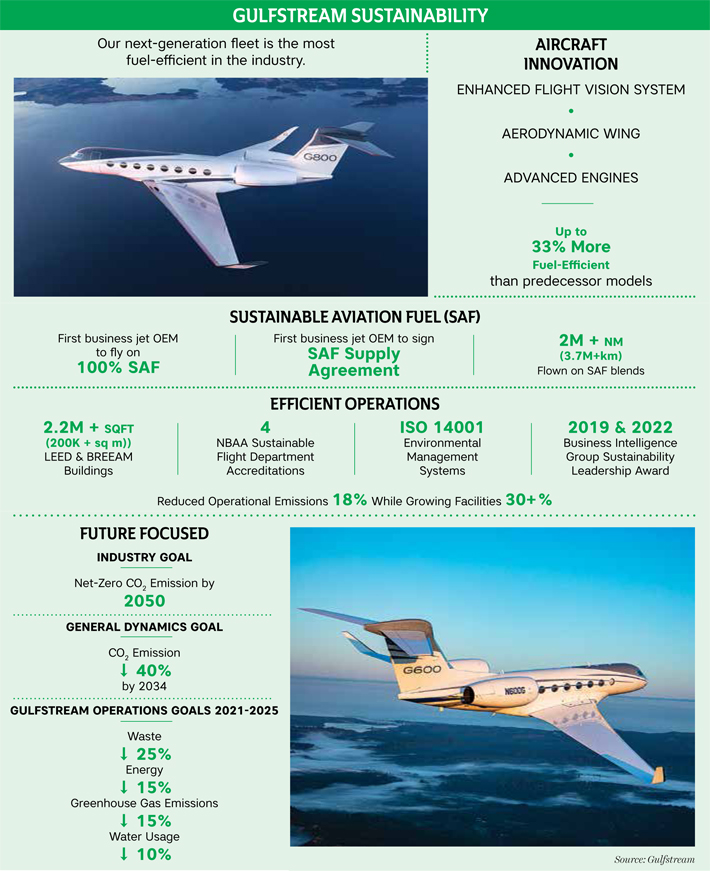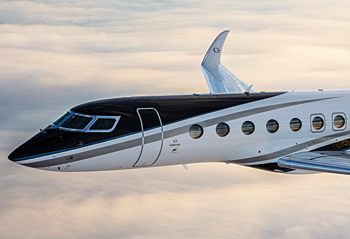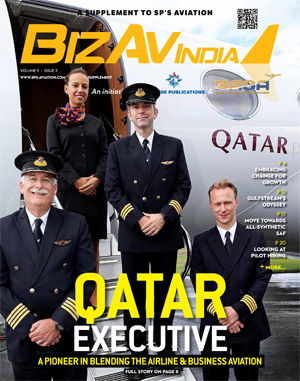Gulfstream’s Eco-Conscious Initiatives
With a steadfast commitment to reducing its carbon footprint and pioneering innovative solutions, Gulfstream’s initiatives for environmental responsibility are leading the industry towards a more sustainable future

Gulfstream Aerospace, a trailblazer in the private jet industry, is spearheading sustainability that sets a new standard for environmental responsibility. Gulfstream significantly focuses on sustainability through aircraft, fuel, operations as well as culture. Since 2014, Gulfstream states it has reduced its operational emissions by 18 per cent while growing its facilities more than 30 per cent. It also boasts of its next-generation fleet as the most fuel-efficient in the industry.
Gulfstream’s commitment to aircraft innovation drives the development of technologies aimed at reducing fuel consumption and minimising environmental impact. The company’s dedication to excellence ensures the creation of high-performance, high-efficiency aircraft tailored to sustainability goals. From advanced avionics enhancing flight safety to state-of-the-art aerodynamics providing range and efficiency advantages, Gulfstream’s innovations prioritise environmental sustainability.
“GULFSTREAM PRIDES ITSELF ON BEING A LEADER IN SUSTAINABILITY. THE RECENT G600 100% SAF FLIGHT WAS AN IMPORTANT STEP IN TESTING THE USE OF 100% SAF IN BOTH ENGINES IN SPECIFIC ENVIRONMENTAL CONDITIONS. THE BUSINESS AVIATION INDUSTRY AS A WHOLE BENEFITS FROM THESE TYPES OF MISSIONS WHICH ALSO SERVE TO BETTER EDUCATE THE PUBLIC ON THE IMPORTANT WORK WE ARE ALL DOING TO REACH THE INDUSTRY’S GOALS OF CARBON NEUTRALITY.”
—MARK BURNS, PRESIDENT, GULFSTREAM
Not just technically but in the realm of interior design too, Gulfstream prioritises responsible choices, offering materials made from renewable resources and recycled content. Sustainable interior finishes include vegetable-dyed, humanely sourced leathers, natural fiber fabrics and carpets, countertops with recycled content, and elegant veneers meeting internationally recognised ecological, social, and ethical standards. Gulfstream’s sustainability programme guides efficient operations, focusing on lowering waste and energy usage through employee engagement, production process improvements, and the adoption of hybrid, electric, and other low-emission vehicles.
Gulfstream continues to lead the way in sustainability, here’s a look at some of its initiatives and achievements.
WORLD’S FIRST TRANS-ATLANTIC FLIGHT USING 100 PER CENT SAF
At the forefront of this endeavor is the recent completion of the world’s first trans-Atlantic flight using 100 per cent sustainable aviation fuel (SAF). Towards the end of last year, Gulfstream Aerospace Corp. announced the successful completion of the world’s first trans-Atlantic flight using 100 per cent SAF. Accomplished on November 19, the flight took place on a Gulfstream G600 aircraft, which departed the company’s headquarters in Savannah and landed 6 hours, 56 minutes later at Farnborough Airport in England. Powered by Pratt & Whitney PW815GA engines, both using 100 per cent SAF, this mission showcased the potential for aviation’s future use of renewable fuels, which feature lower carbon, sulfur and aromatics. The data collected from this endurance flight aims to help Gulfstream and its key suppliers gauge aircraft compatibility with future low-aromatic renewable fuels, particularly under cold temperatures for extended flight durations. The SAF used on the flight was produced by World Energy and delivered by World Fuel Services and comprised of 100 per cent Hydroprocessed Esters and Fatty Acids (neat HEFA), which has at least 70 per cent lower lifecycle CO2 emissions than fossil-based jet fuel, helping to reduce aviation’s impact on climate. Additionally, this zero added aromatics fuel has a reduced impact on local air quality and very low sulfur content, which can reduce non-CO2 environmental impacts. Key partners such as Honeywell, Safran, and Eaton supported this milestone, reflecting Gulfstream’s leadership in advancing sustainable aviation.
ADDING ACHIEVEMENTS AND ACCREDITATIONS
This trans-Atlantic groundbreaking flight is just one aspect of Gulfstream’s multifaceted sustainability initiative. In 2023, Gulfstream also earned four National Business Aviation Association (NBAA) Sustainable Flight Department Accreditations in all four categories including flight, operations, ground support, and infrastructure, a testament to its leadership in sustainability. The NBAA programme, launched in 2022, recognises entities meeting exceptional environmental sustainability standards across flight, ground support, operations, and infrastructure. Gulfstream’s culture of innovation drives sustainable practices through advanced aircraft technology, responsible operations, and investments in SAF.
SPEEDING UP TO SUSTAINABILITY
Last year, Gulfstream also achieved a speed record using SAF with the Gulfstream G700, flying from Savannah to Tokyo at an average speed of Mach 0.89 in 13 hours. This marked the G700’s first visit to Japan and demonstrated Gulfstream’s commitment to sustainability. Gulfstream has surpassed 2 million nautical miles (3.7 million kilometers) flown on SAF blends since 2016, demonstrating the company’s commitment to reducing its carbon footprint. Gulfstream also received the Sustainability Leadership Award from the Business Intelligence Group for the second time, recognising its advocacy for renewable fuel, manufacturing efficiency improvements, and green facility certifications.
CONTINUED COMMITMENT
Additionally, Gulfstream conducted the first flight of the Gulfstream G800 powered by a SAF blend, further showcasing its commitment to advancing sustainable aviation technology. Furthermore, Gulfstream’s Farnborough, England, customer support facility earned ISO 14001 certification for environmental management systems, further solidifying its dedication to environmental stewardship. Gulfstream underlines it uses internationally recognised environmental management systems such as ISO 14001 and considers key details, from incorporating advanced robotics into the production processes to drought-resistant landscaping and energy-saving light, heating, and cooling systems&madsh;all with the goal of making its global network of facilities the most energy-efficient in the industry.

FIRST BIZJET OEM TO SIGN CLEAN SKIES FOR TOMORROW 2030
In 2021, Gulfstream became the first business jet OEM to sign the World Economic Forum’s Clean Skies for Tomorrow 2030 Ambition Statement. This statement outlines the industry’s path to achieving net-zero emissions by 2050 and increasing SAF use. Moreover, Gulfstream demonstrated the performance capabilities of SAF with record-setting flights by the Gulfstream G500, earning the first-ever Sustainable Wings certification from the National Aeronautic Association.
FIRST BUSINESS AIRCRAFT OEM TO FLY ON 100 PER CENT SAF
Additionally, the aerospace manufacturer was the first business aircraft original equipment manufacturer to fly on 100 per cent SAF. Additionally, Gulfstream’s facilities encompass over 2.2 million square feet of green buildings in the US and the UK. With a focus on sustainability, the company has reduced greenhouse gas emissions by 18 per cent since 2014 while expanding facilities by 30 per cent.
Gulfstream is redefining private jet travel through its unwavering commitment to sustainability. From pioneering SAF-powered flights to earning prestigious sustainability accolades, leading the industry towards a greener, more sustainable future in aviation. Its evident that Gulfstream places sustainability at the core of its operations to address environmental concerns in the private jet industry.
“Gulfstream is innovating for a sustainable future,” said Mark Burns, President, Gulfstream. “One of the keys to reaching business aviation’s long-term decarbonisation goals is the broad use of SAF in place of fossil-based jet fuel. The completion of the flight helps to advance business aviation’s overarching sustainability mission and create positive environmental impacts for future generations.”
Gulfstream’s holistic approach to sustainability extends beyond its operations and flight missions. The company’s commitment to sustainability is evident in its carbon offset programmes, which allow operators to mitigate their flights’ environmental impact through contributions to carbon reduction projects. Gulfstream’s continuous improvement initiatives, transparent communication, and collaboration with stakeholders reinforce its dedication to sustainability as a continuous journey.
GULFSTREAM’S PILLARS OF SUSTAINABILITY

Gulfstream’s sustainability strategy encompasses three pillars &madsh; energy and emissions; operations; and culture and learning &madsh; and supports industry goals established by the NBAA, the General Aviation Manufacturers Association (GAMA) and the International Business Aviation Council (IBAC). The goals are a 2 per cent improvement in fuel-efficiency per year from 2010 to 2020; carbon-neutral growth from 2020 onward; and net-zero carbon dioxide emissions by 2050.
SUSTAINABLE CHOICES BEYOND THE ENGINE
- Energy and Emissions: Gulfstream focuses on minimising environmental impact across all operational stages, emphasising aircraft design, fuel efficiency, and ground operations.
- Aircraft Design: Gulfstream prioritises fuel efficiency through advanced engine technologies and aerodynamic designs, reducing fuel consumption and emissions.
- Flight Cycle Optimisation: Collaborating with air traffic control, Gulfstream optimises flight paths and implements continuous improvement initiatives to enhance fuel efficiency.
- Emission Reduction: Gulfstream minimises emissions from ground operations by optimising handling procedures and transitioning to electric or hybrid ground service equipment.
- Operations and Culture: Gulfstream fosters an environmentally responsible culture internally, emphasising employee engagement, sustainable infrastructure, procurement practices, and low-emission transportation.
- Learning: Gulfstream promotes continuous learning and innovation through collaboration with stakeholders, open communication, and investment in research and development.
- Embracing SAF: Gulfstream actively promotes the adoption of SAF, participating in SAF-powered flights to showcase viability and support industry-wide initiatives. They have facilitated over 1.4 million gallons of SAF usage and flown more than 1.5 million nautical miles on SAF-powered flights since 2016.
- Carbon Offset Programmes: Gulfstream offers carbon offset programmes since 2019, allowing operators to offset their flights’ carbon footprint through contributions to carbon reduction projects.
GREEN BUILDINGS
Gulfstream’s commitment to sustainability is further exemplified by its LEED and BREEAM certified green buildings, covering over 2.2 million square feet and decreasing environmental impact and resource consumption. In fueling cleaner flights, Gulfstream supports the development of SAF and regularly flies company and test aircraft on SAF blends. With over 2 million nautical miles flown on SAF blends, Gulfstream has demonstrated the potential to reduce net CO2 emissions by nearly 80 per cent compared to conventional jet fuel.
Fostering a strong sustainability culture, Gulfstream leads with integrity, conserving energy and resources, and supporting local communities. The company continuously proves that it believes in responsible use of natural resources, supports local programmes, and invests in future leaders through student and internship programmes. Recognised with the Business Intelligence Group’s Sustainability Leadership Awards in 2019 and 2022, Gulfstream continues to lead the way in sustainable practices and environmental stewardship.






